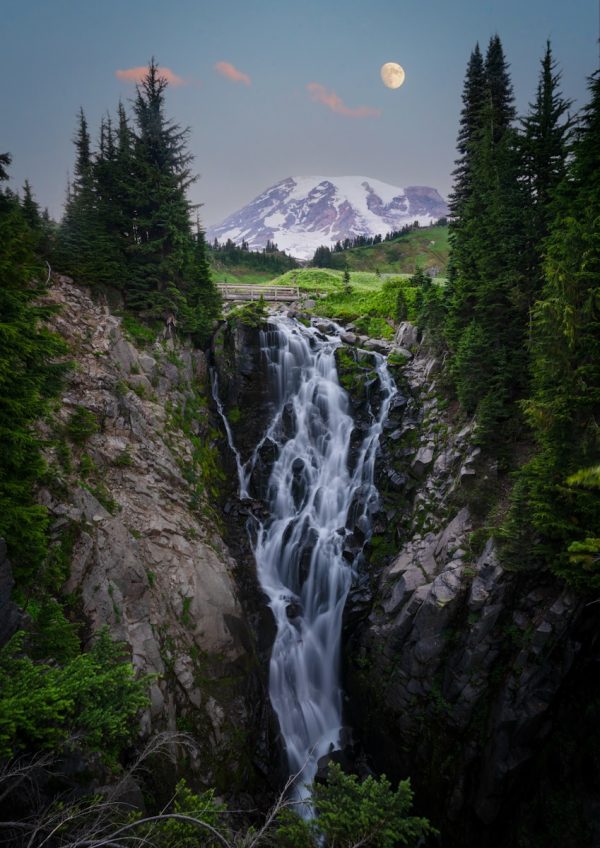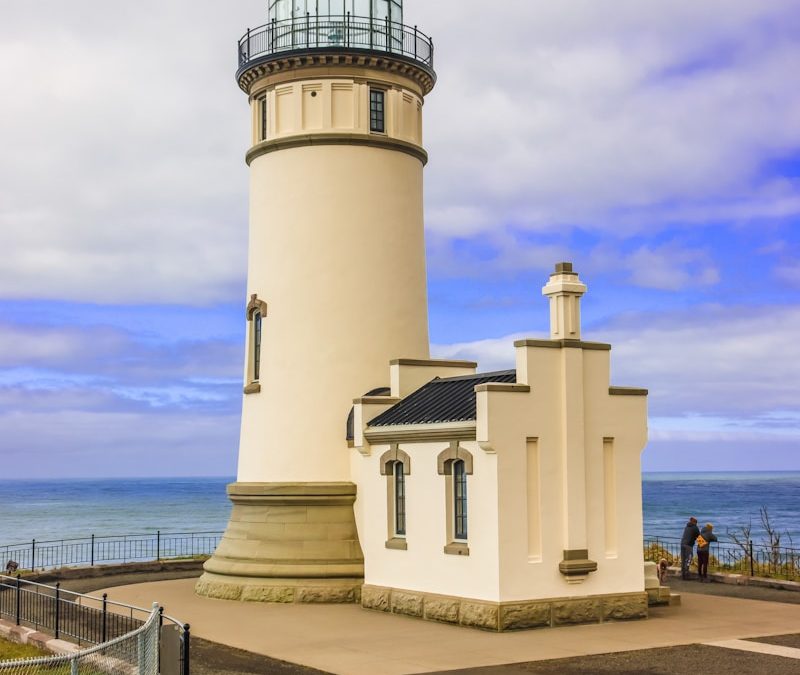Mount Rainier is a majestic stratovolcano located in the Cascade Range of the Pacific Northwest in the United States. It is the highest mountain in the state of Washington, standing at an elevation of 14,411 feet (4,392 meters). Mount Rainier is an active volcano and is considered one of the most dangerous in the world due to its potential for large and explosive eruptions.

Mount Rainier National Park was established in 1899, making it one of the oldest national parks in the United States. The park covers an area of over 236,000 acres and is home to a variety of ecosystems, including subalpine meadows, old-growth forests, and glaciers. Visitors to the park can enjoy hiking, camping, fishing, and wildlife viewing, among other activities.
Mount Rainier has a rich history and cultural significance to the local Native American tribes, who have lived in the area for thousands of years. The mountain is also a popular destination for mountaineers and outdoor enthusiasts, with thousands of people attempting to summit it each year. With its stunning beauty and unique geologic features, Mount Rainier truly is a national treasure.
Geological Formation

Mount Rainier is a stratovolcano located in the Cascade Range of Washington State, USA. It is the highest peak in the state, standing at 14,411 feet (4,392 meters) tall. The mountain is composed of volcanic and sedimentary rocks that were formed over millions of years. The geological formation of Mount Rainier is a fascinating topic that is worth exploring.
Volcanic Activity
Mount Rainier is a young stratovolcano that began forming about 500,000 years ago. The current edifice of the volcano is the result of a series of eruptions that have occurred over the past half-million years. The mountain is composed of andesite and dacite lava flows, which are rich in silica and form steep-sided cones. The volcano has erupted significant amounts of pumice throughout its history, although not as frequently or voluminously as Mount St. Helens.
The most recent eruption of Mount Rainier occurred about 1,000 years ago. Since then, the volcano has been dormant, but it is still considered an active volcano. The risk of an eruption is considered low, but it is not zero. The US Geological Survey closely monitors the volcano for signs of activity.
Glacial History
Mount Rainier has a rich glacial history. The mountain is covered in glaciers, which are formed from snow that accumulates over time. The glaciers on Mount Rainier are some of the largest in the contiguous United States. The mountain has 26 named glaciers, the largest of which is the Emmons Glacier, which covers an area of 4.3 square miles (11.1 square kilometers).
The glaciers on Mount Rainier have been in a state of retreat for the past century. This is due to a combination of factors, including rising temperatures and decreased snowfall. The retreat of the glaciers has had a significant impact on the mountain’s ecosystem, as well as on the surrounding communities. The glaciers are a vital source of water for the region, and their continued retreat could have far-reaching consequences.
In conclusion, the geological formation of Mount Rainier is a complex and fascinating topic. The mountain’s volcanic history and glacial retreat are just two of the many factors that have shaped this iconic peak. Understanding the geological formation of Mount Rainier is essential for anyone who wants to appreciate the mountain’s natural beauty and history.
Geography and Climate

Topography
Mount Rainier is the highest mountain in the state of Washington, with a summit elevation of 14,411 feet (4,392 meters) above sea level. It is located in Mount Rainier National Park, about 59 miles (95 km) south-southeast of Seattle. The mountain is part of the Cascade Range, which stretches from southern British Columbia to northern California.
Mount Rainier is a stratovolcano, which means it is made up of layers of hardened lava, ash, and rock. It has a broad base and a pointed summit, and is surrounded by several glaciers, including the Emmons Glacier, the largest glacier in the contiguous United States.
Weather Patterns
The climate of Mount Rainier is influenced by its high elevation and proximity to the Pacific Ocean. The mountain receives an average of 635 inches (16,128 mm) of snowfall each year, making it one of the snowiest places in the world.
The weather at Mount Rainier can be unpredictable and change quickly, with storms and high winds common at higher elevations. The summer months are generally mild, with temperatures averaging in the 60s and 70s Fahrenheit (15-25 Celsius) during the day. However, temperatures can drop below freezing at night, even in the summer.
Visitors to Mount Rainier should be prepared for a range of weather conditions and dress in layers, with warm clothing and waterproof gear recommended. It is also important to be aware of the risk of avalanches, particularly in the winter months.
Ecology
Mount Rainier National Park is home to a diverse range of ecosystems, each with unique flora and fauna. The park’s ecology is a result of its location in the Cascade Range, its elevation, and its proximity to the Pacific Ocean.
Flora
The park’s flora is characterized by distinct vegetation zones, each corresponding to a specific elevation range. The lowest elevation zone is characterized by dense forests of Douglas fir, western hemlock, and western red cedar. Moving up the mountain, the forest gives way to subalpine meadows dominated by wildflowers such as lupine, paintbrush, and aster. Above the subalpine zone lies the alpine zone, where only the hardiest plants such as mosses, lichens, and dwarf willows can grow.
Fauna
Mount Rainier National Park is home to a variety of wildlife, including mammals, birds, and amphibians. Some of the park’s most iconic species include black bears, mountain goats, and elk. The park is also home to several species of endangered or threatened animals, including the northern spotted owl and the gray wolf.
The park’s streams and rivers are home to a variety of fish species, including rainbow trout and steelhead. Amphibians such as Pacific tree frogs and western toads can also be found in the park’s wetlands and streams.
Overall, Mount Rainier National Park’s ecology is a complex and diverse system that is home to a wide range of plant and animal species. Its unique location and elevation make it a fascinating destination for nature lovers and scientists alike.
Human History
Indigenous Peoples
Indigenous peoples have lived in the area surrounding Mount Rainier for thousands of years. The region was home to several Native American tribes, including the Yakama, Puyallup, and Nisqually. These tribes had a deep spiritual connection to the mountain, which they called Tahoma or Tacoma. They believed that the mountain was a powerful deity and that it held great spiritual significance.
Exploration and Naming
In 1833, a fur trader named Peter Skene Ogden became the first European to see Mount Rainier. He named the mountain after his friend Rear Admiral Peter Rainier. The name was later changed to Tahoma, the name used by the local Native American tribes. However, the name Mount Rainier eventually stuck.
In the late 1800s, explorers and mountaineers began to explore the area around Mount Rainier. They were drawn by the mountain’s stunning beauty and challenging terrain. In 1870, Hazard Stevens and Philemon Beecher Van Trump became the first people to summit Mount Rainier.
National Park Establishment
In 1899, Mount Rainier was established as a national park, making it one of the oldest national parks in the United States. The park was created to protect the mountain’s natural beauty and to provide recreational opportunities for visitors. Mount Rainier was the first national park to allow personal vehicles and to collect entrance fees in 1907. The road to Paradise Park was finished in 1911, making travel to the mountain even easier. Development at the park grew at a torrid and often chaotic pace.
Today, Mount Rainier National Park is a popular destination for hikers, climbers, and nature enthusiasts. The park offers a wide range of recreational opportunities, from hiking and camping to snowshoeing and skiing. Visitors can explore the park’s many trails, take in stunning views of the mountain, and experience the natural beauty of this incredible landscape.
Recreation and Tourism
Hiking and Climbing
Mount Rainier National Park is a popular destination for hiking and climbing enthusiasts. The park offers a variety of trails ranging from easy to difficult, with stunning views of the mountain and the surrounding landscape. Hikers can choose from day hikes or multi-day backpacking trips. Climbers can attempt to summit the mountain, but they must obtain a permit and have the proper equipment and experience. The park also offers guided hikes and climbing programs for those who want to learn from experienced guides.
Visitor Centers
There are several visitor centers located throughout the park, providing visitors with information about the park’s history, geology, and ecology. The Henry M. Jackson Visitor Center, located at Paradise, is the largest and most popular visitor center. It offers exhibits, a theater, a bookstore, and a cafeteria. The Sunrise Visitor Center, located at the highest point in the park accessible by car, offers similar amenities but with a different perspective of the mountain.
Park Regulations
To ensure the safety and preservation of the park, there are several regulations that visitors must follow. For example, pets are not allowed on trails, and visitors must stay on designated trails to prevent damage to the fragile ecosystem. Camping is only allowed in designated campgrounds, and fires are only allowed in established fire rings. Visitors should also be aware of the weather conditions and carry appropriate gear and clothing.
Overall, Mount Rainier National Park is a beautiful and unique destination for outdoor recreation and tourism. Visitors can enjoy hiking, climbing, camping, and learning about the park’s history and ecology at the various visitor centers. However, it is important to follow park regulations to ensure the safety and preservation of this natural wonder.
Conservation Efforts
Mount Rainier National Park has been a protected area since 1899, making it one of the oldest national parks in the world. The park is home to a diverse range of plant and animal species, many of which are threatened or endangered. To protect these species and their habitats, the park has implemented a number of conservation efforts.
One of the most significant conservation efforts in Mount Rainier National Park is the removal of non-native species. Invasive species can have a negative impact on the park’s native plants and animals, and can even alter entire ecosystems. The park works to remove invasive species through a combination of manual removal, herbicide application, and other control methods.
Another important conservation effort in the park is the restoration of degraded habitats. Over the years, human activity and other factors have caused damage to many of the park’s ecosystems. To restore these habitats, the park works to remove barriers to natural processes, such as the reintroduction of fire to certain areas, and the removal of dams and other structures that impede the flow of water.
Finally, the park is involved in a number of sustainability initiatives. These initiatives are designed to reduce the park’s impact on the environment, and to promote sustainable practices among visitors and staff. Some of the initiatives include energy efficiency, green purchasing, recycling, and environmental design.
Overall, Mount Rainier National Park’s conservation efforts are crucial to the long-term health and survival of the park’s ecosystems and the species that call them home. By removing invasive species, restoring degraded habitats, and promoting sustainability, the park is working to ensure that future generations can enjoy the park’s natural beauty and diversity.
Research and Monitoring
Volcanic Monitoring
Mount Rainier is one of the most seismically active volcanoes in the Washington and Oregon Cascades. As a result, it is closely monitored by the Pacific Northwest Seismic Network (PNSN) and the Cascades Volcano Observatory (CVO). The PNSN has been monitoring Mount Rainier’s seismicity since 1985, using a network of seismic stations located within 20 km (12 mi) of the volcano. In an average month, the PNSN locates 3 to 10 earthquakes at Mount Rainier. The CVO also monitors Mount Rainier using GPS and tiltmeters to measure ground deformation, which can indicate movement of magma in the volcano’s interior.
The monitoring data collected by the PNSN and CVO is used to assess the volcano’s activity level and to issue alerts if necessary. The volcano’s activity level is determined by the number and magnitude of earthquakes, the amount and rate of ground deformation, and the presence of volcanic gases. The alerts issued by the CVO range from normal to elevated to volcanic unrest, with the latter indicating that an eruption may be imminent.
Environmental Studies
Mount Rainier National Park is home to a diverse range of ecosystems, including subalpine meadows, old-growth forests, and alpine tundra. These ecosystems are the subject of ongoing environmental studies aimed at understanding their ecology and the impact of human activities on them.
One such study is the Long-Term Ecological Reflections program, which was established in 1993 to monitor the ecological changes in the park over time. The program involves a team of scientists who study the park’s ecosystems and record their observations in journals. The journals are then archived and made available to future researchers.
Another ongoing study is the Mountain Ecosystems Research project, which is a collaboration between the University of Washington and the National Park Service. The project focuses on understanding the effects of climate change on the park’s ecosystems, particularly on the subalpine meadows. The researchers use a combination of field observations, experiments, and computer modeling to predict how the ecosystems will respond to changing environmental conditions.
Overall, the research and monitoring efforts at Mount Rainier National Park are essential for understanding the volcano’s activity level and protecting the park’s ecosystems. By continuing to study and monitor the park, scientists can better understand the complex interactions between the volcano, the environment, and human activities.





0 Comments